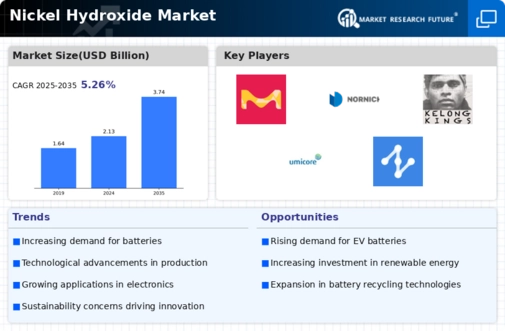Market Share
Nickel Hydroxide Market Share Analysis
The global landscape of electric vehicles (EVs) is undergoing transformative changes, driven by a multitude of initiatives from stakeholders worldwide. This dynamic environment is poised to create substantial growth opportunities for players in the nickel hydroxide sector. Governments on a global scale are increasingly allocating funds to establish EV charging stations and hydrogen fuelling stations. Concurrently, incentives targeting consumers are set to enable Original Equipment Manufacturers (OEMs) to expand their geographical reach and diversify income streams. This strategic investment surge is instrumental in narrowing the price gap between electric vehicles and conventional automobiles, attributed to reduced development and production costs.
The electrification of road transportation is accompanied by the integration of decentralized variable renewable energy sources, such as rooftop solar, which is expected to enhance the reliability of power grid distribution for the EV market. Anticipated investments in digital grid technology and smart charging infrastructure are poised to further catalyze the growth of the electric vehicle market, subsequently bolstering the demand for battery materials, including nickel hydroxide.
In 2010, the Clean Energy Ministerial took a significant step by introducing the Electric Vehicles Initiative (EVI), a multi-governmental policy forum. The EVI, driven by the recognition of the opportunities presented by electric vehicles, is dedicated to accelerating their global adoption. The widespread adoption of EVI across countries is aligned with the shared goal of curbing CO2 emissions, thereby creating additional opportunities for players throughout the supply chain in the electric vehicle market.
Moreover, automakers are intensifying their efforts to introduce new electric options into the market, contributing to the expanding landscape of EVs. The electric vehicle driving range is continuously increasing, with a current market availability of 450 models. The Compound Annual Growth Rate (CAGR) for new electric vehicle models between 2015 and 2021 stands at an impressive 34%, as reported by the International Energy Agency (IEA). This surge in new models reflects a concerted industry push to capture market share for electric vehicles by promptly introducing diverse products, appealing to a broader range of consumers.
Consequently, the increased investment by various stakeholders in the electric vehicle market is expected to act as a driving force behind the growth of nickel hydroxide during the assessment period. This aligns with the overarching trend of sustainability and the global shift towards cleaner and more environmentally friendly transportation options. As the electric vehicle market expands, the demand for advanced battery materials like nickel hydroxide is poised to witness a concurrent upswing, positioning it as a pivotal player in the evolving landscape of electric mobility.








Leave a Comment